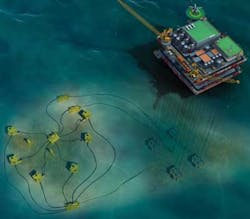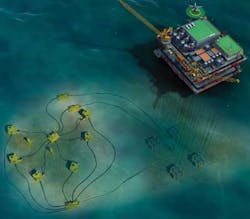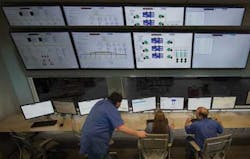Maximizing resource recovery in increasingly complex environments
Richard Ward
President, Completions and Production
Baker Hughes
Ever since oil was discovered at Titusville, Pennsylvania, the petroleum industry has been overcoming one challenge after another to fuel greater economic prosperity. That's the cornerstone of our heritage and we should never lose sight of just how far we've come. In less than 150 years, we have moved from essentially digging a shallow hole in the ground and scooping oil in buckets to routinely uncovering oil resources five and a half miles under the Earth's surface in 10,000 ft of water.
The emerging ultra-deepwater plays clearly promise a significant resource opportunity today and the industry is aggressively pursuing the prize. Rystad Energy recently forecast that over 50% of the total spend on new projects this decade will be for developments in mid- anddeepwater and fully half of these projects are in 5,000 ft or greater water depths. The number of subsea wells is expected to grow from 3,500 in 2012 to more than 8,000 by 2020, or 11,000 if you include both oil and gas wells.
In theGulf of Mexico (GoM) alone, the annual deepwater spend is forecast to grow to approximately $20 billion by the end of the decade and ultra-deepwater Lower Tertiary developments represent almost two-thirds of that total.
Clearly, our challenges aren't getting any easier. In fact, they've never been more daunting. Let's use theGoM Lower Tertiary as the example once again. Getting to the producing reservoir is only the beginning. Once we are there, we have to deal with geologically complex environments with pressures greater than 25,000 psi and bottomhole temperatures hotter than 300° F. Production and injection rates are in the range of 30,000 to 50,000 b/d from one well—through a pipe that is just a few inches in diameter. And often there is little to no vertical permeability.
But, here is the really sobering news. With existing completion and production technology, recovery factors from the Lower Tertiary range from just 6-12%. We are leaving approximately 82% of the estimated recoverable reserves in the ground.
What would it mean if we improved that percentage? Studies indicate that every 1% increase in recovery factor amounts to about 40 MMboe gross.
Historically, drilling was where all the excitement was for our industry—completions and production systems were not the primary focus. If production declined, it was just as affordable to drill another well as it was to invest in figuring out how to get more oil out of existing wells. Not anymore—and certainly not in deepwater plays. Exploring for and drilling wells in deepwater basins is now so costly that the industry has turned its attention to the production phase of a field's life and is looking for innovations to maximize the payback from these massive investments.
I believe there are three core areas that we need to address to ensure deepwater asset objectives are met efficiently and safely:
- Technology development
- A competent workforce
- Integration across all systems and operations.
Technology development
In the Lower Tertiary trend, recovery with natural flow is estimated at less than 10%. But, with dual boosting technology and integrated completions and reservoir management, recovery factors could be increased to more than 20%.
We have to innovate and integrate technology to achieve these results, and that's going to take a new way of working. Integrated project teams (IPT) that employ structured systems engineering methodologies can ensure we meet operators' technical challenges in complex development projects. These IPTs are driven by a clear statement of requirements from the client and consider the challenge from every perspective, including reservoir understanding, advanced component requirements, full system integration, manufacturing, and reliability and quality. The teams are fully integrated, with members from design engineering, marketing, manufacturing, suppliers, quality and reliability, and operations.
One such IPT is our deepwater frontier team, formed in 2012, which is charged with rapidly designing and delivering a fully integrated completion and production system to change reliability standards and recovery factors in this environment.
Since creating these IPTs, we have seen innovation times reduced by as much as 70%.
Investment in research and development capabilities also is necessary to meet the technology requirements of deepwater frontiers. Baker Hughes recognized that need in 2008 when it opened its Center for Technology Innovation. The capability to test new technology up to 40,000 psi and 700° F has resulted in several breakthrough technologies for the high pressure, high temperature environments in plays like the Lower Tertiary.
Earlier this year, the company opened the Artificial Lift Research and Technology Center. At the core of the center are vertical test wells of various diameters and depths to test everything from a single electrical submersible pumping (ESP) system component to the full production system comprised of artificial lift and completion equipment.
Boosting systems are a critical technology to improve recovery factors from deepwater fields, but costly interventions are a serious block to further advancements of the technology. Engineers at the new research center are working on artificial lift designs to achieve unprecedented run times for ESP systems. And the center was designed so that a wireline truck or a coiled tubing rig can be positioned next to the wells to test new, lower-cost intervention techniques.
A competent workforce
The second critical challenge is assuring competent engineers and crews to work in deepwater. Much has been written about the"Great Crew Change" and the statistics from the Society of Petroleum Engineers (SPE) on the age distribution of its membership prove we have reason to be concerned. Nearly 45% of SPE members are over 50 years old.
As an industry we need to recruit and train sufficient engineers to not only address the retirement gap, but also meet future activity levels across all frontier plays. We must have accredited, competence-based training programs that include both classroom and practical application training. We also will need to leverage the existing skilled and competent work groups and individuals through the use of information technology by expanding the capabilities of remote operating centers and knowledge management systems.
Investment in recruitment, training, and competence-based program will not only differentiate companies, but also ensure safe and reliable offshore operations.
Integration across systems and operations
The third hurdle we face is the integration of products and services in the overall operation and production of deepwater assets. Operators and suppliers will need to be aligned and interdependent. We can no longer think and act at the component level. The economic viability of these ultra-deepwater developments depends on seamless integration from the sand face to the production facility.
I can speak from experience of the challenge in developing a fully integrated completions system. It is considerable. Then, when you add in the interface to seabed architecture such as boosting systems, processing plants, power, and automation, just to name a few, the level of complexity grows by orders of magnitude.
Design requirements need to be developed by all parties and functions based on reservoir interpretation, development strategy, and production targets.
The integration of applied technology teams will be critical to develop the technology necessary to build systems that integrate the subsurface, in-well, and the subsea infrastructure. This approach is as important in brownfield environments as it is in greenfield developments.
The requisite level of integration will take more than just technology. It will take a universal culture change in how we think and how we work, across every function that touches the well directly or indirectly. To fully mitigate risk and maximize recovery, collaboration is no longer an option-it's fundamental to operations. Seamless integration of perspectives will help us turn data into valuable information, leading to better holistic solutions.
If we are successful on all three of the fronts I have outlined, I believe that in the not too distance future we will create living wells – wells that can measure changes in the reservoir to help make the right decisions and take the necessary actions to get more reserves out of the ground over the life of the well.
Living wells will be able to "talk" to each other and adjust automatically to critical changes in seconds or over decades to preserve the integrity of the entire field and maximize recovery. These wells will even be able to heal themselves, while continuing to produce at maximum recovery rates, by remotely managing flow rates, or pressures, or a host of other parameters.
These are exciting times in the oil field. This decade will see monumental changes in how we conquer deepwater frontiers, ensuring that we continue to deliver safe, affordable energy.



